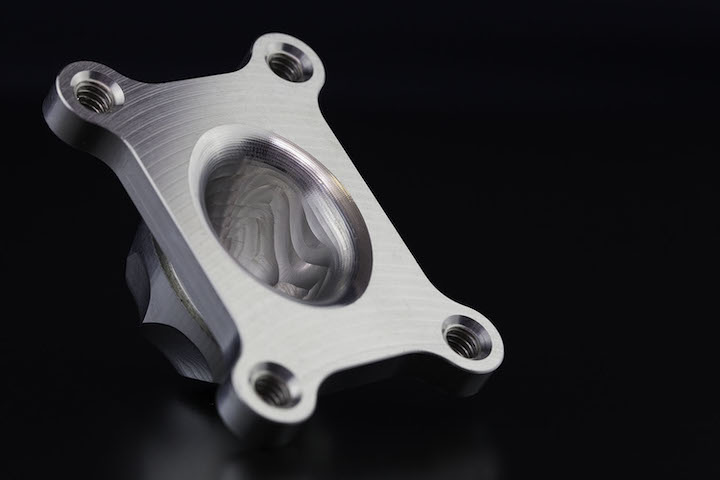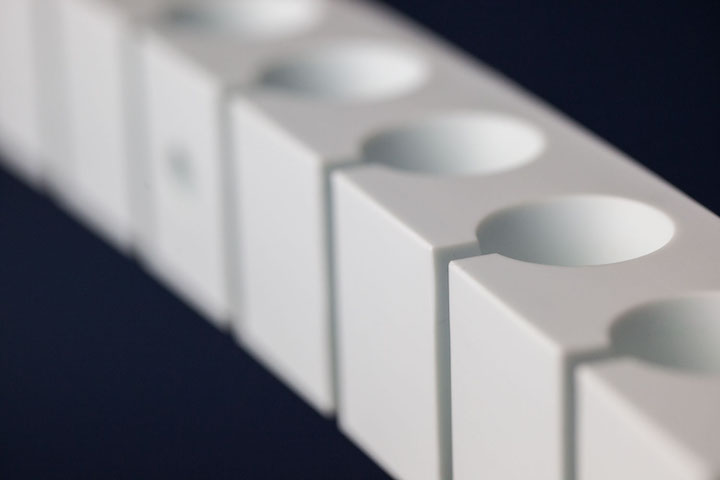Time to read: 6 min
CNC machining is a subtractive manufacturing technique that uses computer-controlled machines to turn raw materials into finished products. It’s a detailed and efficient process used across industries, including aerospace, automotive, and medical device manufacturing.
The process starts by using computer-aided design (CAD) software to create a 2D drawing, 3D solid model, or both. This design is then changed into a series of instructions (a CNC program) and fed into the CNC machine using G-code. The machine then uses these instructions to direct and operate the cutting tools, which remove material to create the desired shape and size.

CNC machining is a versatile process that produces parts from various materials like metal, plastic, wood, or composites. CNC machines can execute a variety of manufacturing processes, including: CNC drilling, CNC milling, CNC turning, CNC EDM Cutting, CNC Gear Hobbing, and CNC grinding.
CNC machines produce parts rapidly and reliably with high accuracy and precision, and can create complex shapes that would be difficult or impossible to accomplish manually. CNC machining has transformed the manufacturing landscape and its importance couldn’t be more significant in 2023. This article will discuss the CNC machining process, from raw materials to the finished product.
How Does CNC Machining Work?
In CNC machining, a computer program commands the movements of a cutting machine to automate the production process with minimal human intervention. Here’s how it works:
- Before beginning CNC machining, a part is designed using Computer-Aided Design (CAD) software to create a 3D model of the item, a 2D drawing, or both. The model will later be changed into a program that the CNC machine can read.
Pro-Tip: For tips on designing your CNC machined parts, check out 3D Modeling: From Fundamentals to Advanced Techniques.
- The most critical phase in CNC machining is choosing the correct raw material for your project. The material could be a block of plastic, metal, or wood. The raw material should be sufficiently strong to endure the machining process.
- Before stock material is loaded in a CNC machine, the program for manufacturing the part must be developed — fortunately, modern CAM software can develop the code for you. Modern CNC machines are programmed by loading a solid 3D model in CAM software, which contains guidelines on the machine’s development, the tools to use, and how much material to remove. The CAM software outputs G-Code that the machine can read, which, depending on the CNC machine, provides a sequence of tool speeds, tool selections, coolant flow rates, tool location, and time for each operation. Then the machine follows the program’s instructions, and the raw material is progressively removed from the workpiece.
- Before machining, the raw material is fixtured into the CNC machine by various methods using jigs or fixtures.
- Next, the material is machined — either the CNC machine tooling moves to make contact with the workpiece or vice versa, depending on the type of machine.
- While you should always design with quality in mind, quality control measures are taken throughout the machining system to guarantee that the final product meets the required specifications. Accuracy instruments like micrometers and gauges are used to ensure quality, and if the product doesn’t meet the required specifications, the program is changed and the machining process is repeated.
- The final step is finishing once the machining process is completed. During this step, the machined component is examined, cleaned, and polished — other finishing, such as plating, powder coating, chemical conversion coating, or tumbling may also be required. The finished product is then ready to be used or assembled with other parts.
CNC Machine Components
A CNC machine is a complex assembly of several components that work together to create precision parts. The spindle is the core of the machine and turns the cutting tool. Device holders secure the cutting apparatus in place, while the control board allows the operator to input commands and monitor the machine’s activity. To learn more about the 13 key components of a CNC machine, check out Parts of a CNC Machine Explained.
Types of CNC Machines
There are many types of CNC machines, each designed for specific applications. CNC milling machines utilize rotary cutting instruments to remove material from a workpiece, while CNC lathes use turning devices to shape the material. CNC routers are used for cutting and molding wood, plastic, and different materials, while plasma cutters utilize a high-temperature plasma torch to cut metal.
Watch our video of a CNC Lathe with live tooling to see a CNC machine in action.
Cutting Tools
There are a variety cutting tools available for CNC machines. End mills are utilized for processing activities, while drills are utilized for making openings. Taps are utilized to make inside strings, while reamers are utilized to make smooth and exact openings.

Material Selection
Many variables must be accounted for when choosing the right material for CNC machining, including the ideal properties of the completed component, the required level of accuracy, and the cost. Metals like aluminum, steel, and titanium are routinely utilized in CNC machining, as are some plastics and composites. Material properties, like strength, hardness, and protection from wear, should be considered when choosing the raw material for your application.
Pro-Tip: For tips on material selection, check out How to Select & Source the Right Materials
Advancements in CNC Machining
Advancements in CNC machining technology have changed the manufacturing industry in recent years, allowing for expanded accuracy, speed, and efficiency. These advancements in CNC machining include:
Multi-Axis Machining
Multi-axis machines can move the cutting tool along multiple axes, allowing for more complex geometries. For example, five-axis machines can move the tool along three linear axes and two rotational axes, which allows for the machining of complex shapes and parts with fewer setups.
High-Speed Machining
High-speed machining (HSM) uses advanced cutting tools and techniques to remove material quickly and efficiently. HSM machines work at higher rates than customary CNC machines to deliver faster machining times and better surface finishing.
Additive Manufacturing
Additive manufacturing, also known as 3D printing, has become well-known for making complex components with intricate geometries. CNC machines can be equipped with additive manufacturing capabilities to produce components layer by layer, utilizing materials such as plastics, metals, and ceramics.
Automation and Robotics
CNC machines can be equipped with automation and robotics capabilities to further increase efficiency and effectiveness. Robots can load and unload workpieces, while automated tool changers rapidly switch out cutting devices, and machine vision systems can review parts and identify defects automatically.
Digital Twin Technology
Digital twin technology lets you create a virtual replica of a physical CNC machine that is utilized to enhance the machine’s performance and identify potential issues before they occur. This technology leverages sensors and analytics to gather information about the machine’s performance and make a digital model that simulates the machine’s behavior.
Internet of Things (IoT) Integration
IoT integration connects CNC machines to the internet and enables real-time data collection and analysis. This technology monitors machine performance, predicts maintenance needs, and optimizes machine usage. Additionally, it can track the progress of a component as it moves through the manufacturing process, providing better visibility and control to customers.
Applications for CNC Machining
CNC machining is a vital part of modern manufacturing, using advanced computer-controlled machines to manufacture finished products with a high degree of precision. Its flexibility and efficiency in making complex designs and shapes make it a dynamic tool for various industries, including aerospace, automotive, and medical device manufacturing.
CNC machining services continue to evolve and remain a critical component of the manufacturing industry, providing a cost-effective and reliable means of producing high-quality finished goods from raw materials. With the significant advantages of CNC machining, it will remain an essential part of the product development and manufacturing process.
Fictiv – Your CNC Machining Partner
Fictiv is your operating system for custom manufacturing that makes CNC part procurement faster, easier, and more efficient. We have some of the most advanced CNC machines and skilled operators in the world, which is how we can deliver precision CNC parts in as little as 2 days!










